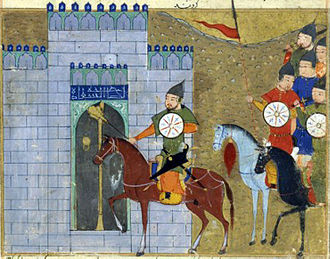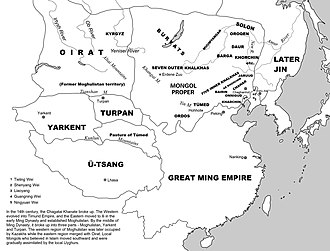Inner Mongolia






Inner Mongolia (Mongolian: ᠦᠪᠦᠷ ᠮᠣᠩᠭᠣᠯ, Öbür Monggol; Simplified Chinese: 内蒙古; Traditional Chinese: 內蒙古; Pinyin: Nèi Měnggǔ), officially the Inner Mongolia Autonomous Region (IMAR), is an autonomous region of the People's Republic of China, located in the northern region of the country. Inner Mongolia borders Mongolia to the north and Russia to the northeast, while domestically, it is bordered by eight Chinese provinces, making it the third-largest subdivision of China by area.
History[edit]
The history of Inner Mongolia is intertwined with the history of the Mongol Empire and the subsequent establishment of the Qing Dynasty, which incorporated the region into its territory. The area has been inhabited by the Mongols and other nomadic tribes for centuries, playing a crucial role in the Silk Road and serving as a critical frontier for various Chinese dynasties.
Geography[edit]
Inner Mongolia is characterized by its vast grasslands, deserts, including the famous Gobi Desert, and mountain ranges. The region's geography is diverse, with the Altai Mountains, Great Khingan Range, and the Yin Mountains being some of the significant geographical features. The Yellow River and the Yarlung Tsangpo River are among the major rivers flowing through the region.
Economy[edit]
The economy of Inner Mongolia is diverse, with a strong emphasis on agriculture, energy production, and mining. The region is rich in resources, including coal, rare earth elements, and other minerals, making it a significant player in China's energy sector. Additionally, Inner Mongolia is one of China's largest livestock and dairy production areas, contributing significantly to the country's agricultural output.
Culture[edit]
Inner Mongolia's culture is a blend of traditional Mongolian and Chinese elements. The region is famous for its traditional music, dance, and the Naadam festival, which includes activities such as horse racing, archery, and wrestling. The Mongolian language, alongside Mandarin Chinese, is an official language of the region, reflecting its unique cultural identity.
Administrative Divisions[edit]
Inner Mongolia is divided into 12 prefecture-level divisions: 9 cities and 3 leagues, which are further subdivided into banners and counties. Hohhot serves as the capital and the largest city of the region, being a central hub for politics, economy, and culture.
Environmental Issues[edit]
The region faces several environmental challenges, including desertification, deforestation, and water scarcity. Efforts are being made to combat these issues through various conservation projects and policies aimed at sustainable development.
Tourism[edit]
Inner Mongolia is a popular tourist destination, known for its natural beauty and cultural heritage. Attractions include the Xilamuren Grassland, Hulun Lake, and the Mausoleum of Genghis Khan, which draw visitors interested in exploring the region's landscapes and history.
Ad. Transform your life with W8MD's Budget GLP-1 injections from $75


W8MD offers a medical weight loss program to lose weight in Philadelphia. Our physician-supervised medical weight loss provides:
- Weight loss injections in NYC (generic and brand names):
- Zepbound / Mounjaro, Wegovy / Ozempic, Saxenda
- Most insurances accepted or discounted self-pay rates. We will obtain insurance prior authorizations if needed.
- Generic GLP1 weight loss injections from $75 for the starting dose.
- Also offer prescription weight loss medications including Phentermine, Qsymia, Diethylpropion, Contrave etc.
NYC weight loss doctor appointmentsNYC weight loss doctor appointments
Start your NYC weight loss journey today at our NYC medical weight loss and Philadelphia medical weight loss clinics.
- Call 718-946-5500 to lose weight in NYC or for medical weight loss in Philadelphia 215-676-2334.
- Tags:NYC medical weight loss, Philadelphia lose weight Zepbound NYC, Budget GLP1 weight loss injections, Wegovy Philadelphia, Wegovy NYC, Philadelphia medical weight loss, Brookly weight loss and Wegovy NYC
|
WikiMD's Wellness Encyclopedia |
| Let Food Be Thy Medicine Medicine Thy Food - Hippocrates |
Medical Disclaimer: WikiMD is not a substitute for professional medical advice. The information on WikiMD is provided as an information resource only, may be incorrect, outdated or misleading, and is not to be used or relied on for any diagnostic or treatment purposes. Please consult your health care provider before making any healthcare decisions or for guidance about a specific medical condition. WikiMD expressly disclaims responsibility, and shall have no liability, for any damages, loss, injury, or liability whatsoever suffered as a result of your reliance on the information contained in this site. By visiting this site you agree to the foregoing terms and conditions, which may from time to time be changed or supplemented by WikiMD. If you do not agree to the foregoing terms and conditions, you should not enter or use this site. See full disclaimer.
Credits:Most images are courtesy of Wikimedia commons, and templates, categories Wikipedia, licensed under CC BY SA or similar.
Translate this page: - East Asian
中文,
日本,
한국어,
South Asian
हिन्दी,
தமிழ்,
తెలుగు,
Urdu,
ಕನ್ನಡ,
Southeast Asian
Indonesian,
Vietnamese,
Thai,
မြန်မာဘာသာ,
বাংলা
European
español,
Deutsch,
français,
Greek,
português do Brasil,
polski,
română,
русский,
Nederlands,
norsk,
svenska,
suomi,
Italian
Middle Eastern & African
عربى,
Turkish,
Persian,
Hebrew,
Afrikaans,
isiZulu,
Kiswahili,
Other
Bulgarian,
Hungarian,
Czech,
Swedish,
മലയാളം,
मराठी,
ਪੰਜਾਬੀ,
ગુજરાતી,
Portuguese,
Ukrainian
